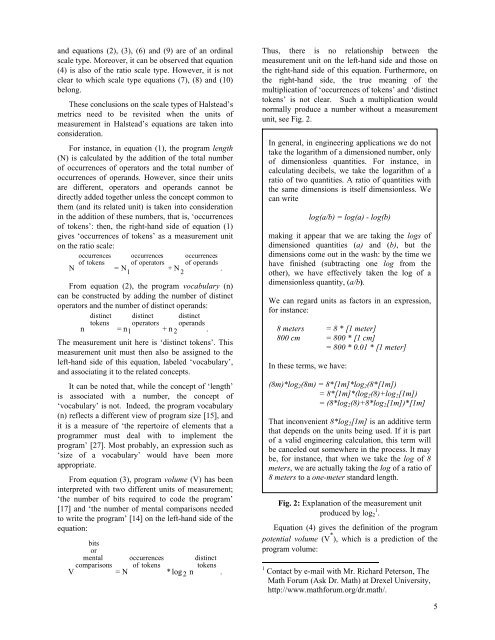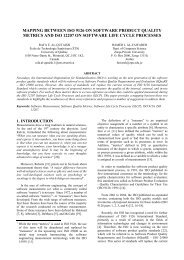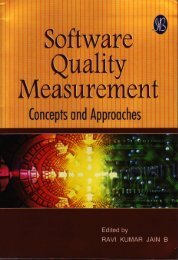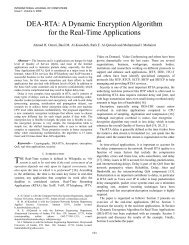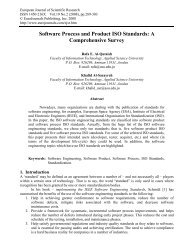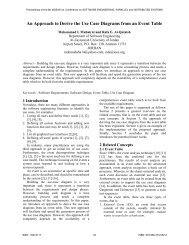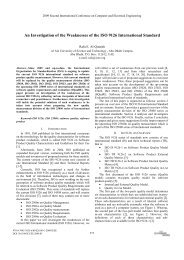where S is <strong>the</strong> Stroud number 1 , defined as <strong>the</strong>number <strong>of</strong> elementary discriminationsperformed by <strong>the</strong> human brain per second. The Svalue for s<strong>of</strong>tware scientists is set to 18 [17].The unit <strong>of</strong> measurement <strong>of</strong> T is <strong>the</strong> second.All <strong>the</strong> above ten equations are based on <strong>the</strong>results <strong>of</strong> n 1 , n 2 , N 1 , N 2 , n * 1 <strong>and</strong> n * 2 , which<strong>the</strong>mselves are based on a counting strategy toclassify <strong>the</strong> program tokens as operators or oper<strong>and</strong>s.Unfortunately, <strong>the</strong>re is a problem in distinguishingbetween operators <strong>and</strong> oper<strong>and</strong>s. This problem occursbecause Halstead has provided an example 2 withspecific illustrations <strong>of</strong> operators <strong>and</strong> oper<strong>and</strong>s, butwithout generic definitions applicable to any programcontext. That is, Halstead has not explicitly described<strong>the</strong> generic measurable concepts <strong>of</strong> operators <strong>and</strong>oper<strong>and</strong>s. He has asserted only that – in <strong>the</strong> examplehe provides – <strong>the</strong>ir description is intuitively obvious<strong>and</strong> requires no fur<strong>the</strong>r explanation. In practice, formeasurement purposes, intuition is insufficient toobtain accurate, repeatable <strong>and</strong> reproduciblemeasurement results.Therefore, it is important that <strong>the</strong> countingstrategy be clearly defined <strong>and</strong> consistent, since allHalstead’s s<strong>of</strong>tware science depends on counts <strong>of</strong>operators <strong>and</strong> oper<strong>and</strong>s [18]. However, <strong>the</strong>re is nogeneral agreement among researchers on <strong>the</strong> mostmeaningful way to classify <strong>and</strong> count <strong>the</strong>se tokens[19]. Hence, individual researchers (<strong>and</strong> practitionersas well) must state <strong>the</strong>ir own interpretation or,alternatively, use one <strong>of</strong> <strong>the</strong> available countingstrategies proposed by o<strong>the</strong>r researchers, such as in[20-23]. Fur<strong>the</strong>rmore, Li et al. have proposed rulesfor identifying operators <strong>and</strong> oper<strong>and</strong>s in <strong>the</strong> objectorientedprogramming (OOP) languages [24].Of course, it is to be expected that differentcounting strategies will produce different values <strong>of</strong> n 1 ,n 2 , N 1 <strong>and</strong> N 2, <strong>and</strong>, consequently, different values for<strong>the</strong> above ten equations.4. <strong>An</strong>alysis <strong>of</strong> <strong>the</strong> <strong>Design</strong> <strong>and</strong> <strong>Definitions</strong><strong>of</strong> Halstead’s <strong>Metrics</strong>4.1. Defining <strong>the</strong> ContextThe objective <strong>of</strong> Halstead’s metrics is to measure<strong>the</strong> following characteristics <strong>of</strong> a program: length,vocabulary, volume, level, difficulty <strong>and</strong> intelligence1 In 1967, a psychologist, John M. Stroud, suggestedthat <strong>the</strong> human mind is capable <strong>of</strong> making a limitednumber <strong>of</strong> mental discrimination per second (StroudNumber), in <strong>the</strong> range <strong>of</strong> 5 to 20.2 Halstead’s book [3], pp. 6-8.content. In addition, <strong>the</strong>y are used to measuring whatis referred to as “o<strong>the</strong>r characteristics” <strong>of</strong> <strong>the</strong>developer: programming effort <strong>and</strong> requiredprogramming time. All <strong>the</strong>se measures are based onlyon <strong>the</strong> number <strong>of</strong> operators <strong>and</strong> <strong>the</strong> number <strong>of</strong>oper<strong>and</strong>s <strong>the</strong> given program or algorithm contains.The last two attributes, which refer to adeveloper’s attributes (programming effort <strong>and</strong>required programming time), seem to be identical,since ‘effort to write a program’ is similar to‘required programming time’.4.2. <strong>Design</strong>ing <strong>the</strong> measurement4.2.1. The empirical <strong>and</strong> numerical worlds <strong>and</strong><strong>the</strong>ir mappingThe entities that can be used to apply Halstead’smetrics are <strong>the</strong> source code itself or <strong>the</strong> algorithm <strong>of</strong>that source code. However, applying Halstead’smetrics to <strong>the</strong>se two entities will produce differentvalues for <strong>the</strong> same base measures. For example, inJava language, <strong>the</strong> number <strong>of</strong> operators in <strong>the</strong> sourcecode is different from <strong>the</strong> number <strong>of</strong> operators in <strong>the</strong>equivalent algorithm for that source code, since – asan example – in Java source code, each statementmust be end with a semicolon (;), which is anoperator.Halstead’s metrics are based on two attributes: <strong>the</strong>number <strong>of</strong> operators <strong>and</strong> <strong>the</strong> number <strong>of</strong> oper<strong>and</strong>s. Asmentioned in section 3, <strong>the</strong>re is no agreement on howto distinguish between operators <strong>and</strong> oper<strong>and</strong>s.Therefore, different counting strategies will producedifferent numbers <strong>of</strong> operators <strong>and</strong> oper<strong>and</strong>s for <strong>the</strong>same program or algorithm. The two attributes can beeasily mapped to a ma<strong>the</strong>matical structure bycounting <strong>the</strong> number <strong>of</strong> operators <strong>and</strong> oper<strong>and</strong>s in <strong>the</strong>program source code or <strong>the</strong> equivalent algorithm.Fur<strong>the</strong>rmore, Kiricenko <strong>and</strong> Orm<strong>and</strong>jieva [25]investigated <strong>the</strong> validation <strong>of</strong> <strong>the</strong> representationcondition for Halstead’s program length metric.4.2.2. The measurement methodTo obtain a value for each <strong>of</strong> Halstead’s metrics,ten equations have to be computed (see section 3). Itis to be noted that all <strong>of</strong> <strong>the</strong>se equations (equations 1to 10) correspond to a ‘derived measure’, as definedby <strong>the</strong> international vocabulary <strong>of</strong> basic <strong>and</strong> generalterms in metrology (VIM) <strong>and</strong> <strong>the</strong> ISO 15939.Equation (3) is <strong>of</strong> a ratio scale type, whileequation (5) is <strong>of</strong> an ordinal scale type, as noted byFenton <strong>and</strong> Pfleeger [16]. By contrast, Zuse [26]maintains that equation (1) is <strong>of</strong> <strong>the</strong> ratio scale type4
<strong>and</strong> equations (2), (3), (6) <strong>and</strong> (9) are <strong>of</strong> an ordinalscale type. Moreover, it can be observed that equation(4) is also <strong>of</strong> <strong>the</strong> ratio scale type. However, it is notclear to which scale type equations (7), (8) <strong>and</strong> (10)belong.These conclusions on <strong>the</strong> scale types <strong>of</strong> Halstead’smetrics need to be revisited when <strong>the</strong> units <strong>of</strong>measurement in Halstead’s equations are taken intoconsideration.For instance, in equation (1), <strong>the</strong> program length(N) is calculated by <strong>the</strong> addition <strong>of</strong> <strong>the</strong> total number<strong>of</strong> occurrences <strong>of</strong> operators <strong>and</strong> <strong>the</strong> total number <strong>of</strong>occurrences <strong>of</strong> oper<strong>and</strong>s. However, since <strong>the</strong>ir unitsare different, operators <strong>and</strong> oper<strong>and</strong>s cannot bedirectly added toge<strong>the</strong>r unless <strong>the</strong> concept common to<strong>the</strong>m (<strong>and</strong> its related unit) is taken into considerationin <strong>the</strong> addition <strong>of</strong> <strong>the</strong>se numbers, that is, ‘occurrences<strong>of</strong> tokens’: <strong>the</strong>n, <strong>the</strong> right-h<strong>and</strong> side <strong>of</strong> equation (1)gives ‘occurrences <strong>of</strong> tokens’ as a measurement uniton <strong>the</strong> ratio scale:occurrences occurrences occurrences<strong>of</strong> tokens <strong>of</strong> operators <strong>of</strong> oper<strong>and</strong>sN= N+ N.12From equation (2), <strong>the</strong> program vocabulary (n)can be constructed by adding <strong>the</strong> number <strong>of</strong> distinctoperators <strong>and</strong> <strong>the</strong> number <strong>of</strong> distinct oper<strong>and</strong>s:distinct distinct distincttokens operators oper<strong>and</strong>sn = n1+ n 2 .The measurement unit here is ‘distinct tokens’. Thismeasurement unit must <strong>the</strong>n also be assigned to <strong>the</strong>left-h<strong>and</strong> side <strong>of</strong> this equation, labeled ‘vocabulary’,<strong>and</strong> associating it to <strong>the</strong> related concepts.It can be noted that, while <strong>the</strong> concept <strong>of</strong> ‘length’is associated with a number, <strong>the</strong> concept <strong>of</strong>‘vocabulary’ is not. Indeed, <strong>the</strong> program vocabulary(n) reflects a different view <strong>of</strong> program size [15], <strong>and</strong>it is a measure <strong>of</strong> ‘<strong>the</strong> repertoire <strong>of</strong> elements that aprogrammer must deal with to implement <strong>the</strong>program’ [27]. Most probably, an expression such as‘size <strong>of</strong> a vocabulary’ would have been moreappropriate.From equation (3), program volume (V) has beeninterpreted with two different units <strong>of</strong> measurement;‘<strong>the</strong> number <strong>of</strong> bits required to code <strong>the</strong> program’[17] <strong>and</strong> ‘<strong>the</strong> number <strong>of</strong> mental comparisons neededto write <strong>the</strong> program’ [14] on <strong>the</strong> left-h<strong>and</strong> side <strong>of</strong> <strong>the</strong>equation:Vbitsormentalcomparisonsoccurrences distinct<strong>of</strong> tokenstokens= N * log2n .Thus, <strong>the</strong>re is no relationship between <strong>the</strong>measurement unit on <strong>the</strong> left-h<strong>and</strong> side <strong>and</strong> those on<strong>the</strong> right-h<strong>and</strong> side <strong>of</strong> this equation. Fur<strong>the</strong>rmore, on<strong>the</strong> right-h<strong>and</strong> side, <strong>the</strong> true meaning <strong>of</strong> <strong>the</strong>multiplication <strong>of</strong> ‘occurrences <strong>of</strong> tokens’ <strong>and</strong> ‘distincttokens’ is not clear. Such a multiplication wouldnormally produce a number without a measurementunit, see Fig. 2.In general, in engineering applications we do nottake <strong>the</strong> logarithm <strong>of</strong> a dimensioned number, only<strong>of</strong> dimensionless quantities. For instance, incalculating decibels, we take <strong>the</strong> logarithm <strong>of</strong> aratio <strong>of</strong> two quantities. A ratio <strong>of</strong> quantities with<strong>the</strong> same dimensions is itself dimensionless. Wecan writelog(a/b) = log(a) - log(b)making it appear that we are taking <strong>the</strong> logs <strong>of</strong>dimensioned quantities (a) <strong>and</strong> (b), but <strong>the</strong>dimensions come out in <strong>the</strong> wash: by <strong>the</strong> time wehave finished (subtracting one log from <strong>the</strong>o<strong>the</strong>r), we have effectively taken <strong>the</strong> log <strong>of</strong> adimensionless quantity, (a/b).We can regard units as factors in an expression,for instance:8 meters = 8 * [1 meter]800 cm = 800 * [1 cm]= 800 * 0.01 * [1 meter]In <strong>the</strong>se terms, we have:(8m)*log 2 (8m) = 8*[1m]*log 2 (8*[1m])= 8*[1m]*(log 2 (8)+log 2 [1m])= (8*log 2 (8)+8*log 2 [1m])*[1m]That inconvenient 8*log 2 [1m] is an additive termthat depends on <strong>the</strong> units being used. If it is part<strong>of</strong> a valid engineering calculation, this term willbe canceled out somewhere in <strong>the</strong> process. It maybe, for instance, that when we take <strong>the</strong> log <strong>of</strong> 8meters, we are actually taking <strong>the</strong> log <strong>of</strong> a ratio <strong>of</strong>8 meters to a one-meter st<strong>and</strong>ard length.Fig. 2: Explanation <strong>of</strong> <strong>the</strong> measurement unitproduced by log 1 2 .Equation (4) gives <strong>the</strong> definition <strong>of</strong> <strong>the</strong> programpotential volume (V * ), which is a prediction <strong>of</strong> <strong>the</strong>program volume:1 Contact by e-mail with Mr. Richard Peterson, TheMath Forum (Ask Dr. Math) at Drexel University,http://www.mathforum.org/dr.math/.5


